Abstract
In this study, sexual risk behavior of 104 incarcerated female drug users is examined. Findings demonstrate that incarcerated women who use drugs are at high risk for human immunodeficiency virus (HIV) infection because of their behavior prior to arrest. During the month prior to arrest, the majority of respondents were sexually active. Half reported past sexual contacts with injecting drug users, and more than one-third had traded sex for money or drugs. Consistent with other studies, condom use was more frequent with casual or commercial partners. Those who traded sex for money were less likely to be white Anglo or regular heroin users, and more likely to be regular crack users and alcoholic, have fathers who were drug or alcohol users, and perceive themselves as at-risk for contracting HIV and other sexually transmitted diseases.
Full text
PDF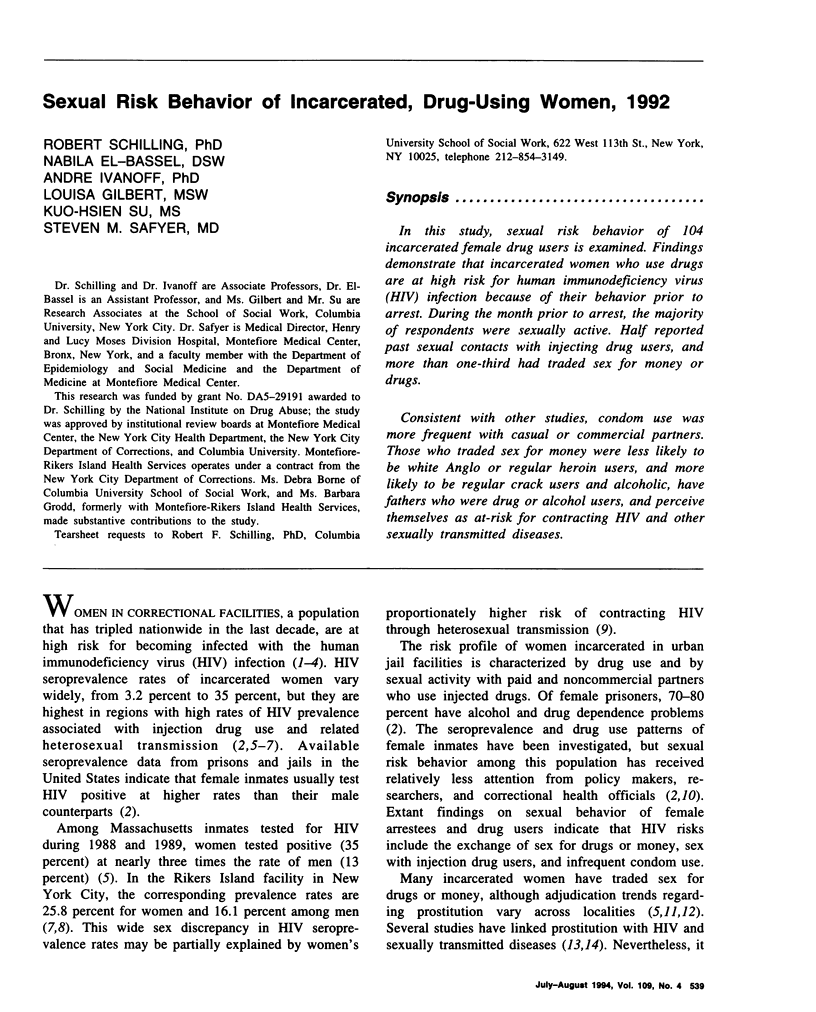

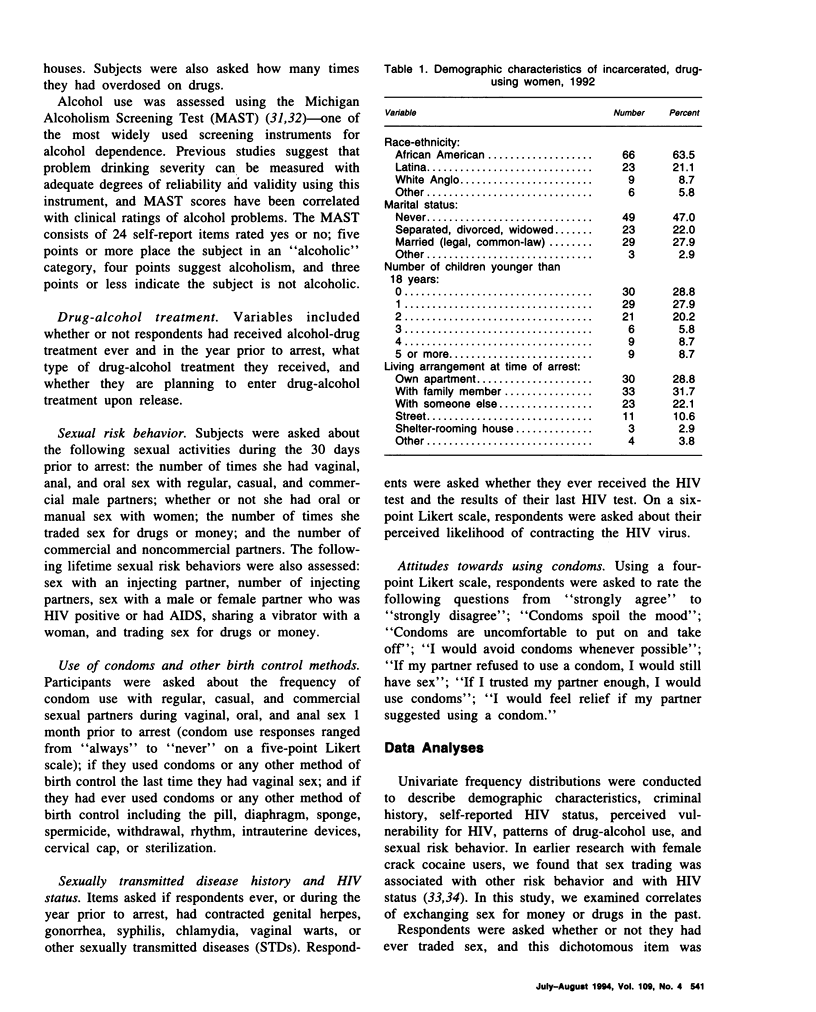

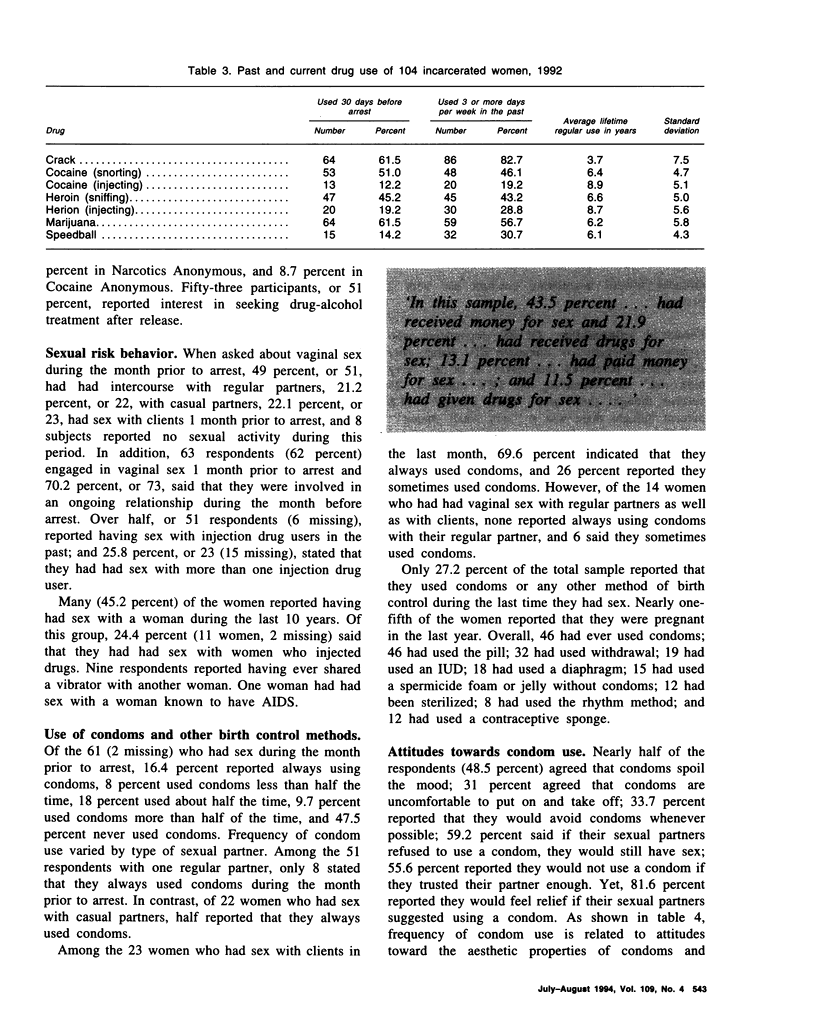
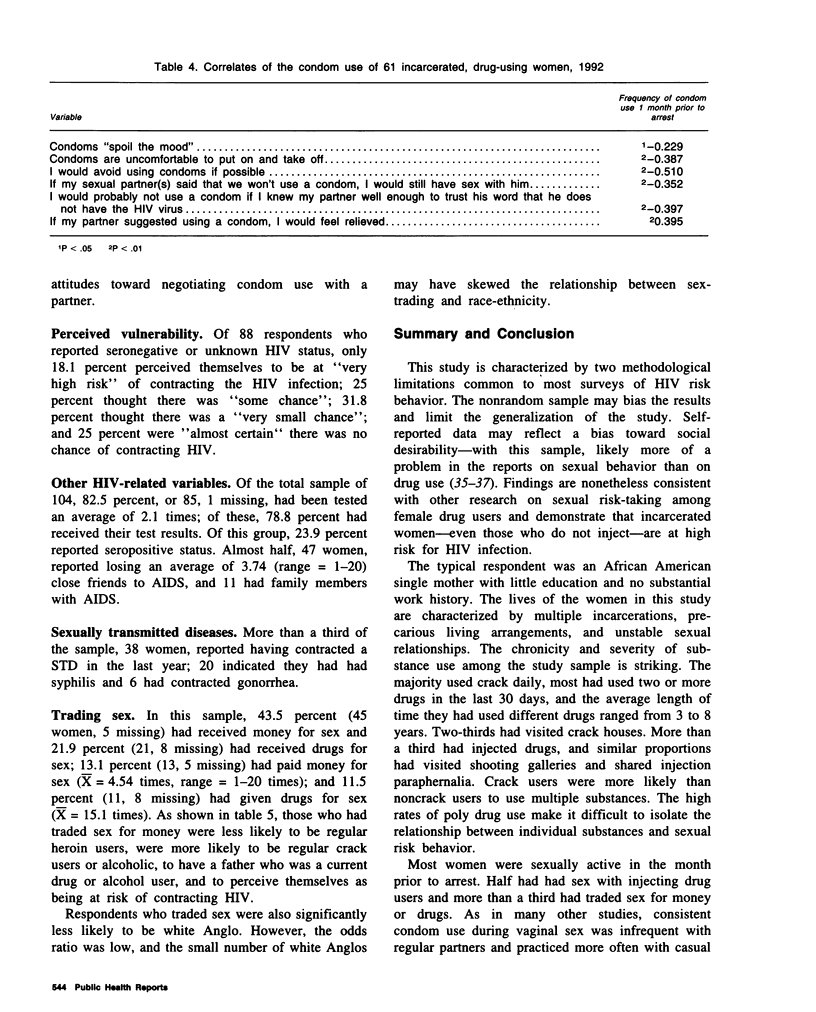
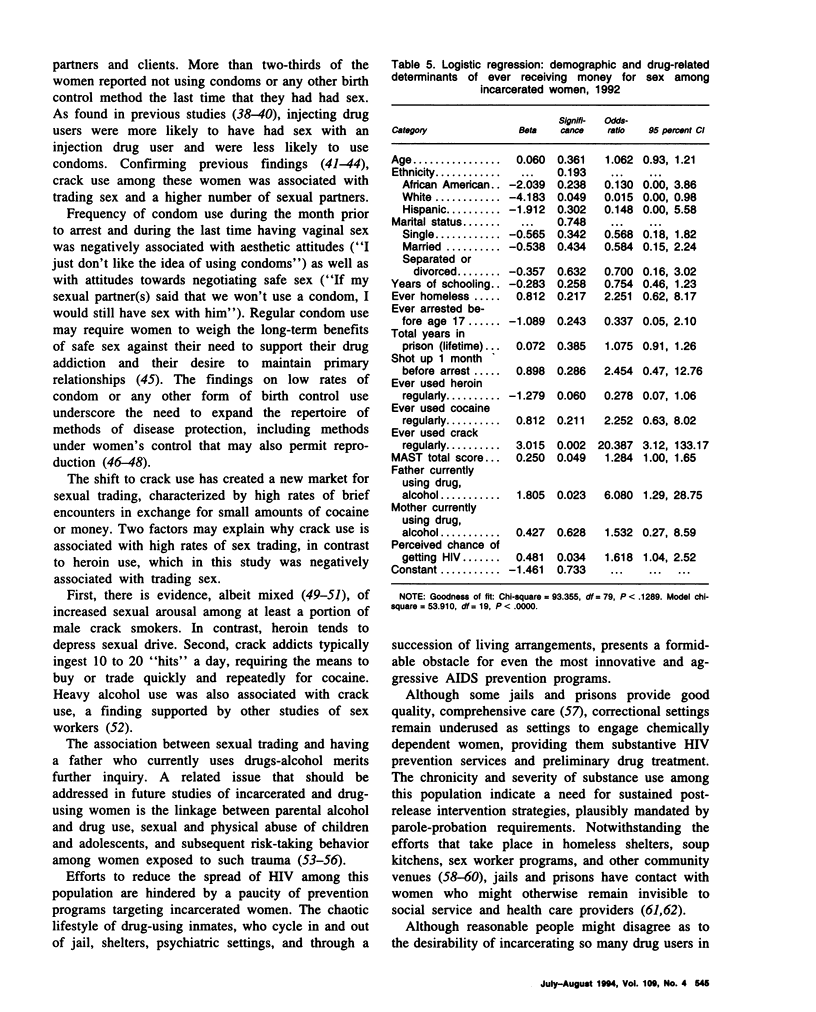
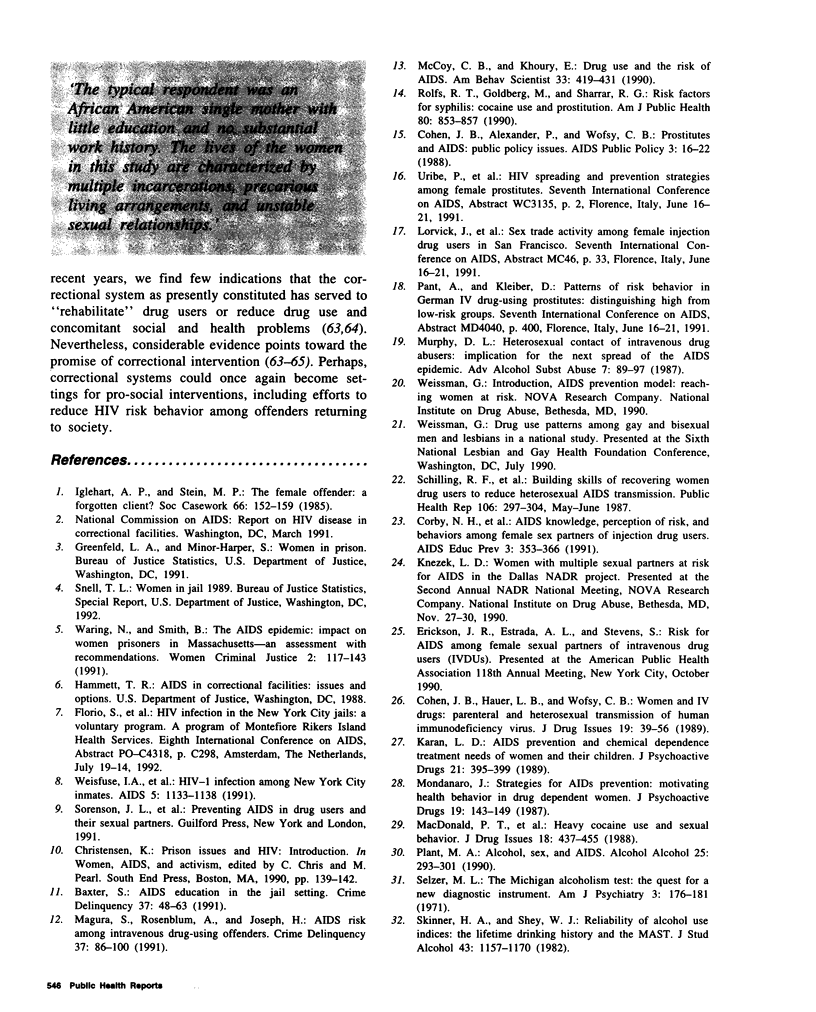
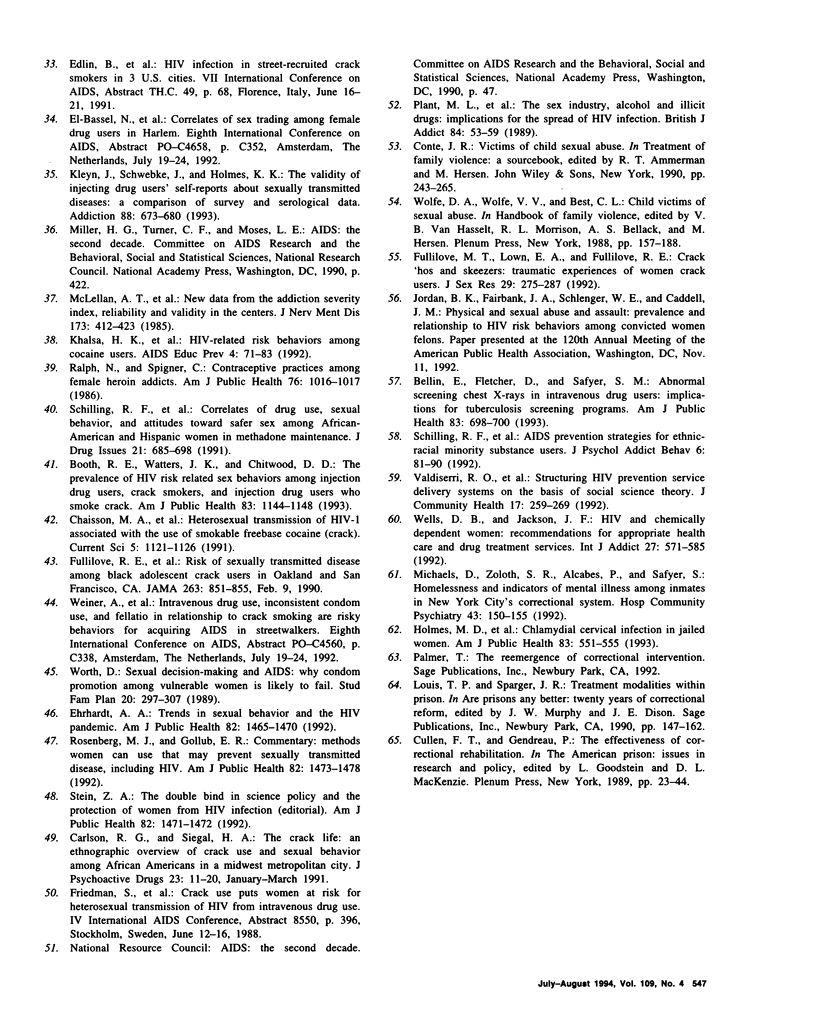
Selected References
These references are in PubMed. This may not be the complete list of references from this article.
- Bellin E., Fletcher D., Safyer S. Abnormal chest x-rays in intravenous drug users: implications for tuberculosis screening programs. Am J Public Health. 1993 May;83(5):698–700. doi: 10.2105/ajph.83.5.698. [DOI] [PMC free article] [PubMed] [Google Scholar]
- Booth R. E., Watters J. K., Chitwood D. D. HIV risk-related sex behaviors among injection drug users, crack smokers, and injection drug users who smoke crack. Am J Public Health. 1993 Aug;83(8):1144–1148. doi: 10.2105/ajph.83.8.1144. [DOI] [PMC free article] [PubMed] [Google Scholar]
- Carlson R. G., Siegal H. A. The crack life: an ethnographic overview of crack use and sexual behavior among African-Americans in a midwest metropolitan city. J Psychoactive Drugs. 1991 Jan-Mar;23(1):11–20. doi: 10.1080/02791072.1991.10472570. [DOI] [PubMed] [Google Scholar]
- Castro K. G., Valdiserri R. O., Curran J. W. Perspectives on HIV/AIDS epidemiology and prevention from the Eighth International Conference on AIDS. Am J Public Health. 1992 Nov;82(11):1465–1470. doi: 10.2105/ajph.82.11.1465. [DOI] [PMC free article] [PubMed] [Google Scholar]
- Corby N. H., Wolitski R. J., Thornton-Johnson S., Tanner W. M. AIDS knowledge, perception of risk, and behaviors among female sex partners of injection drug users. AIDS Educ Prev. 1991 Winter;3(4):353–366. [PubMed] [Google Scholar]
- Fullilove R. E., Fullilove M. T., Bowser B. P., Gross S. A. Risk of sexually transmitted disease among black adolescent crack users in Oakland and San Francisco, Calif. JAMA. 1990 Feb 9;263(6):851–855. [PubMed] [Google Scholar]
- Holmes M. D., Safyer S. M., Bickell N. A., Vermund S. H., Hanff P. A., Phillips R. S. Chlamydial cervical infection in jailed women. Am J Public Health. 1993 Apr;83(4):551–555. doi: 10.2105/ajph.83.4.551. [DOI] [PMC free article] [PubMed] [Google Scholar]
- Karan L. D. AIDS prevention and chemical dependence treatment needs of women and their children. J Psychoactive Drugs. 1989 Oct-Dec;21(4):395–399. doi: 10.1080/02791072.1989.10472183. [DOI] [PubMed] [Google Scholar]
- Khalsa H. K., Kowalewski M. R., Anglin M. D., Wang J. HIV-related risk behaviors among cocaine users. AIDS Educ Prev. 1992 Spring;4(1):71–83. [PubMed] [Google Scholar]
- Kleyn J., Schwebke J., Holmes K. K. The validity of injecting drug users' self-reports about sexually transmitted diseases: a comparison of survey and serological data. Addiction. 1993 May;88(5):673–680. doi: 10.1111/j.1360-0443.1993.tb02080.x. [DOI] [PubMed] [Google Scholar]
- McLellan A. T., Luborsky L., Cacciola J., Griffith J., Evans F., Barr H. L., O'Brien C. P. New data from the Addiction Severity Index. Reliability and validity in three centers. J Nerv Ment Dis. 1985 Jul;173(7):412–423. doi: 10.1097/00005053-198507000-00005. [DOI] [PubMed] [Google Scholar]
- Michaels D., Zoloth S. R., Alcabes P., Braslow C. A., Safyer S. Homelessness and indicators of mental illness among inmates in New York City's correctional system. Hosp Community Psychiatry. 1992 Feb;43(2):150–155. doi: 10.1176/ps.43.2.150. [DOI] [PubMed] [Google Scholar]
- Mondanaro J. Strategies for AIDS prevention: motivating health behavior in drug dependent women. J Psychoactive Drugs. 1987 Apr-Jun;19(2):143–149. doi: 10.1080/02791072.1987.10472398. [DOI] [PubMed] [Google Scholar]
- Murphy D. L. Heterosexual contacts of intravenous drug abusers: implications for the next spread of the AIDS epidemic. Adv Alcohol Subst Abuse. 1987;7(2):89–97. [PubMed] [Google Scholar]
- Plant M. A. Alcohol, sex and AIDS. Alcohol Alcohol. 1990;25(2-3):293–301. doi: 10.1093/oxfordjournals.alcalc.a045003. [DOI] [PubMed] [Google Scholar]
- Plant M. L., Plant M. A., Peck D. F., Setters J. The sex industry, alcohol and illicit drugs: implications for the spread of HIV infection. Br J Addict. 1989 Jan;84(1):53–59. doi: 10.1111/j.1360-0443.1989.tb00551.x. [DOI] [PubMed] [Google Scholar]
- Ralph N., Spigner C. Contraceptive practices among female heroin addicts. Am J Public Health. 1986 Aug;76(8):1016–1017. doi: 10.2105/ajph.76.8.1016. [DOI] [PMC free article] [PubMed] [Google Scholar]
- Rolfs R. T., Goldberg M., Sharrar R. G. Risk factors for syphilis: cocaine use and prostitution. Am J Public Health. 1990 Jul;80(7):853–857. doi: 10.2105/ajph.80.7.853. [DOI] [PMC free article] [PubMed] [Google Scholar]
- Rosenberg M. J., Gollub E. L. Commentary: methods women can use that may prevent sexually transmitted disease, including HIV. Am J Public Health. 1992 Nov;82(11):1473–1478. doi: 10.2105/ajph.82.11.1473. [DOI] [PMC free article] [PubMed] [Google Scholar]
- Schilling R. F., el-Bassel N., Schinke S. P., Gordon K., Nichols S. Building skills of recovering women drug users to reduce heterosexual AIDS transmission. Public Health Rep. 1991 May-Jun;106(3):297–304. [PMC free article] [PubMed] [Google Scholar]
- Skinner H. A., Sheu W. J. Reliability of alcohol use indices. The Lifetime Drinking History and the MAST. J Stud Alcohol. 1982 Nov;43(11):1157–1170. doi: 10.15288/jsa.1982.43.1157. [DOI] [PubMed] [Google Scholar]
- Stein Z. A. The double bind in science policy and the protection of women from HIV infection. Am J Public Health. 1992 Nov;82(11):1471–1472. doi: 10.2105/ajph.82.11.1471. [DOI] [PMC free article] [PubMed] [Google Scholar]
- Valdiserri R. O., West G. R., Moore M., Darrow W. W., Hinman A. R. Structuring HIV prevention service delivery systems on the basis of social science theory. J Community Health. 1992 Oct;17(5):259–269. doi: 10.1007/BF01324356. [DOI] [PubMed] [Google Scholar]
- Weisfuse I. B., Greenberg B. L., Back S. D., Makki H. A., Thomas P., Rooney W. C., Rautenberg E. L. HIV-1 infection among New York City inmates. AIDS. 1991 Sep;5(9):1133–1138. doi: 10.1097/00002030-199109000-00013. [DOI] [PubMed] [Google Scholar]
- Wells D. V., Jackson J. F. HIV and chemically dependent women: recommendations for appropriate health care and drug treatment services. Int J Addict. 1992 May;27(5):571–585. doi: 10.3109/10826089209063469. [DOI] [PubMed] [Google Scholar]
- Worth D. Sexual decision-making and AIDS: why condom promotion among vulnerable women is likely to fail. Stud Fam Plann. 1989 Nov-Dec;20(6 Pt 1):297–307. [PubMed] [Google Scholar]


